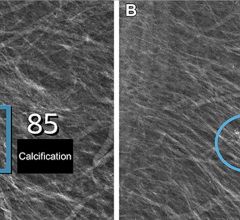May 3, 2011 – Screening mammography benefits women between 40 and 49 years of age, and excluding this population from annual exams under the revised Preventative Service Task Force (USPSTF) mammography guidelines would negatively impact survival. The announcement is according to research presented at the American Society of Breast Surgeons Annual Meeting.
A 10-year retrospective study conducted at the University of Missouri in Columbia, Mo., found that mammography detected smaller tumors with less nodal metastasis than identified through clinical (manual) breast exams among women in this age group.
“Breast cancer has a better prognosis when treated before tumors become palpable and identifiable through a physician or self-breast exam,” said researcher Paul Dale, M.D., chief of surgical oncology, Ellis Fischel Cancer Center at the University of Missouri School of Medicine. “The study also found mammographically detected patients also had better outcomes.”
The study looked at 1581 breast cancer patients treated between 1998 and 2008. Twenty percent of patients were between the ages of 40 and 49. Forty-seven percent of patients were diagnosed through mammography and 53 percent through clinical exams or other non-mammographic methods. In the mammography group, the mean tumor size was 20 mm in diameter, while non-mammographically identified tumors were 30 mm. The study also found that the frequency of lymph node involvement in the clinically detected groups was about twice that of mammographically detected patients.
Five year disease-free survival rate was estimated statistically through survival analysis methodology at 94 percent for mammography group and 78 percent for those identified clinically. Node negativity and tumor size were significantly associated with an increase in survival.
“We found that 20 percent of breast cancer patients in our institution are under age 50, and almost half of their tumors were detected through mammography,” Dale said. “Given recent advances in targeted treatment of early stage cancer, under these new guidelines, younger breast cancer patients not undergoing screening and early detection may miss out on important therapy that could significantly impact their survival.”
For more information: www.breastsurgeons.org


 July 29, 2024
July 29, 2024 








